cloudHQ Review
A cloud-to-cloud management service that gets a lot right, we hesitate to truly recommend cloudHQ due to its high price tag. That said, it's still one of the better services among a generally sad lot, as you can read in our cloudHQ review.
Cloud storage services have become an inseparable part of our digital lives. We use so many of them to store so much of our data that it’s become necessary to have an app to manage them all. This is where cloud-to-cloud management apps such as cloudHQ come in. In this exhaustive cloudHQ review, we’ll go over the entire app to highlight its pros and cons.
Key Takeaways:
- cloudHQ is a cloud-to-cloud management service with a fantastic free plan that allows you to have unlimited sync and backup of your free cloud accounts.
- It has great security features, which include two-factor authentication and a GDPR-compliant privacy policy.
- Limited sharing options and a lack of some basic tools — such as the search option and file previews — keep it from being a truly superb app.
cloudHQ ranks very high on our best cloud-to-cloud management services list, and with good reason. It has some standout features that even our top pick, MultCloud, lacks. Additionally, cloudHQ offers a free plan that allows you to sync your free cloud storage accounts. Keep reading this full cloudHQ review for all the details.
- 1
- 2
- 3
- 4$5 / month(All Plans)
- 5$1.83 / month(All Plans)
Strengths & Weaknesses
Pros:
- Enticing free plan
- One-way & two-way sync
- Two-factor authentication
Cons:
- Expensive
- No desktop & mobile apps
- No search or file previews
Features
cloudHQ is a cloud-to-cloud management service that focuses on providing sync and backup between different cloud apps. Cloud services that you connect to cloudHQ can be set up to have one-way or two-way syncing. One-way sync is used to migrate or backup data from one cloud service to another, while two-way sync means that files in both services will be the same.
Unfortunately cloudHQ offers only continuous sync, as it lacks the option to schedule syncing. This can be good for certain situations where you need continuous sync for backup purposes, but the lack of fine control and customization could be an issue for some users.
10,000+ Trust Our Free Cloud Storage Tips. Join Today!
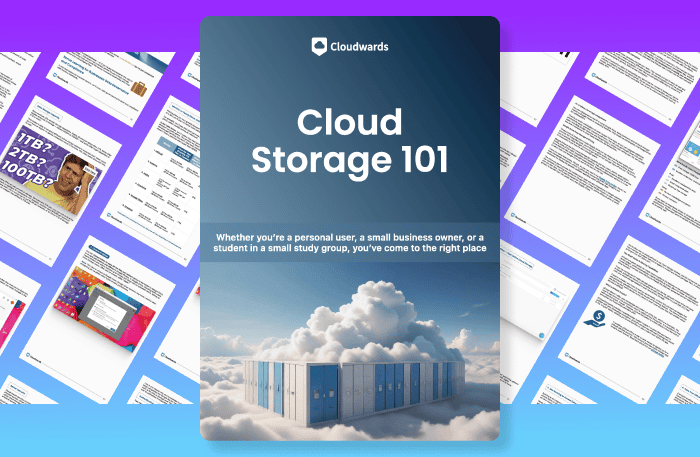
- Demystify cloud storage terminology and key concepts in plain language
- Discover easy-to-implement techniques to securely backup and sync your data across devices
- Learn money-saving strategies to optimize your cloud storage costs and usage
Basically, when it comes to file transfers and setting up sync relationships between cloud storage services, cloudHQ is a more than competent cloud-to-cloud management service. However, when you require anything more than this from it, you will often find yourself wishing that it was a more advanced app with better tools and more diverse options.
cloudHQ Sharing
Sharing in cloudHQ works a bit differently than it does in most other apps. Usually, you select a file and then create a sharing link; you can email or send this link to a collaborator and they will then have access to this file. In cloudHQ, you first have to enable the Gmail Label Sharing option before you can share anything.
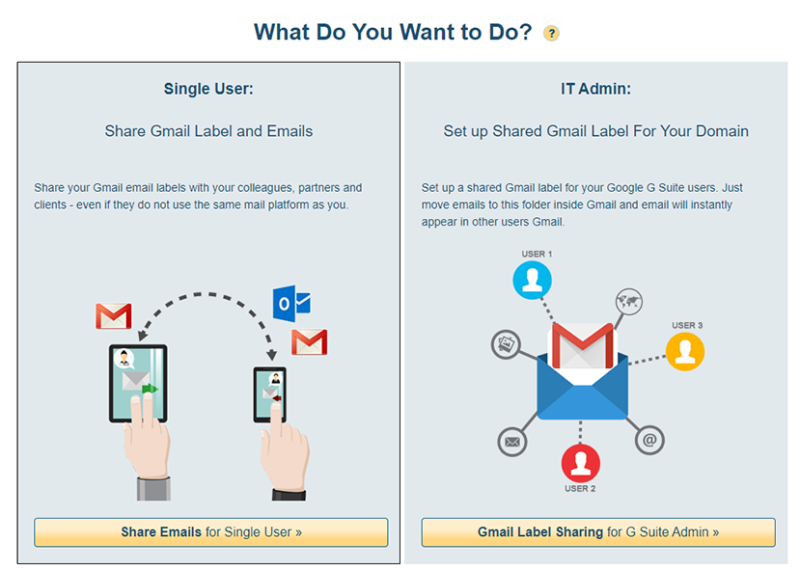
After you give cloudHQ access to your Gmail account, you will be able to share folders or Gmail tags and labels with other people. For example, you can share all the Gmail emails you have starred, or you can create an entirely new label and make everything with that label available for sharing.
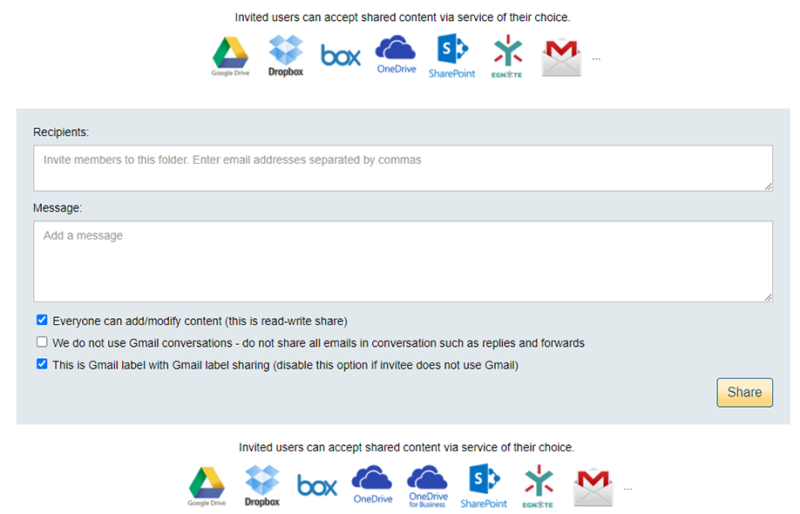
When you specify a folder you would like to share, you can invite other members to collaborate with you on your projects. As the folder’s owner, you can give members permission to add, delete and edit the files in that folder. Otherwise, the files will be shared as read-only. This is a great option, but we would like it even better if there were different levels of permissions you could grant.
The contents of your shared folders will appear in your collaborator’s preferred cloud service. For example, if you are working on a Basecamp project while your coworkers are using Box, when they receive and accept your invitation, this Basecamp project will then be shared inside their Box folder.
cloudHQ Features Overview
| Features | |
|---|---|
| Free Account | |
| Max Cloud Connections | Unlimited |
| WebDAV Support | |
| FTP Support | |
| Web Interface | |
| Mobile Apps | |
| Desktop Client | |
| Upload Files | |
| Cloud-to-Cloud Transfer | |
| Cloud-to-Cloud Sync | |
| Cloud-to-Cloud Backup | |
| File Sharing | |
| Work Spaces | |
| Image Preview | |
| Document Preview | |
| Stream Media | |
| Open File in Original Service | |
| Search Files | |
| Work chat | |
| Two-Factor Authenticaion | |
| In-Transit Encryption | |
| End-to-End Encryption |
Pricing
cloudHQ has a free option and three distinct paid subscription plans. The free plan is unique among cloud-to-cloud management services and warrants its own separate section, so first we will explore each paid option to see how they compare to one another and what they offer. The three paid plans are Premium, Business and Enterprise.
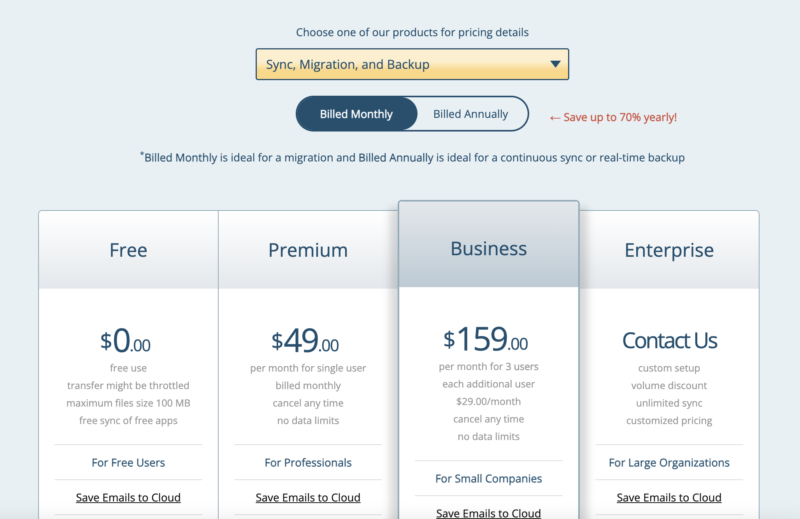
All paid plans feature a 30-day money-back guarantee (applicable only for annual plans), the option to cancel at any time and customer service options. Most importantly, these plans also don’t have data traffic limits when backing up and syncing with premium cloud accounts.
Compared to the competition, such as MultCloud — see our MultCloud vs cloudHQ comparison — cloudHQ comes off as very expensive and much less suited for personal use.
cloudHQ Paid Plans: Unlimited Cloud-to-Cloud Transfer
Charged per user, the Premium plan costs $49 a month or $149 on an annual payment plan. The Premium plan is marketed toward individual users, and with it, you get all the advantages of the free plan, plus unlimited backup and sync of premium cloud accounts such as Box Business. We’ll cover which other cloud services and protocols cloudHQ supports later in this article.
The Business plan is geared toward small companies. This plan is priced at $159 a month or $399 a year for three users, with each additional user costing $29 per month or $79 per year. It includes business cloud accounts, such as Egnyte (one of the best enterprise file sync and share services), and project management software like Asana and Basecamp.
Finally, we have the Enterprise plan. Intended for large corporations, it has custom pricing and you will have to contact cloudHQ directly to get a price estimate. The company promises a volume-based discount, so this may be the most cost-effective plan for an enterprise that plans to have a lot of employees using this app.
cloudHQ Free Cloud Storage: Cloud-to-Cloud Transfer for Free
cloudHQ’s free service is very appealing in some regards, but it also comes with some major downsides that limit its overall usefulness. Its biggest strength is the way it handles free cloud storage accounts. Most other cloud-to-cloud management apps that have a free option limit the data traffic you can have per month, regardless of which cloud storage services you’ve connected to it.
cloudHQ’s free version operates differently. You get to add a number of cloud storage accounts to it; however, you can connect only the free cloud service accounts. For example, you can add the free version of our top-rated note taking app, Evernote, but not Evernote’s two paid plans — Evernote Premium and Evernote Business.
The upside is that there are no limits to the amount of cloud-to-cloud data transfers you can sync and backup. Free services that can be integrated include some of the most popular cloud apps such as Dropbox, Google Drive and OneDrive. The maximum file size on the free plan is 150MB and the transfer speeds might get throttled. Another drawback is the lack of customer support.
One final thing that you should be aware of with cloudHQ’s free plan is that it cannot be used for any commercial purposes without the express permission from cloudHQ. However, if you are a user that just wants an app where you can connect and sync your personal free cloud storage services, cloudHQ’s free plan can’t be beat.
Ease of Use
Using cloudHQ is a pretty straightforward and simple process. Everything is handled over its web-based user interface. As such, there is no cloudHQ desktop or mobile app available. If having a desktop client is really important for you, we recommend giving odrive a try (you can read about it in our odrive review).
The service isn’t particularly rich in features, so it’s pretty easy to use. Having more options, tools and features is usually a good thing, but they can also make an app unnecessarily difficult to use and hard to figure out. cloudHQ avoids this common issue through its sheer simplicity.
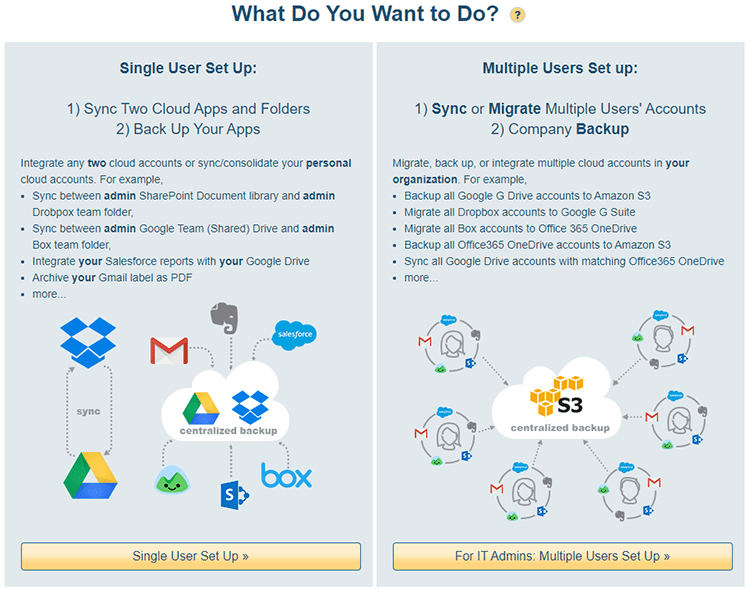
The first step is to create a cloudHQ account. After you have done so, cloudHQ will then inquire whether you are a single user who wants to sync and backup your own cloud storage apps, or if you are an IT admin who is looking to sync and migrate multiple user accounts and conduct a company-wide backup.
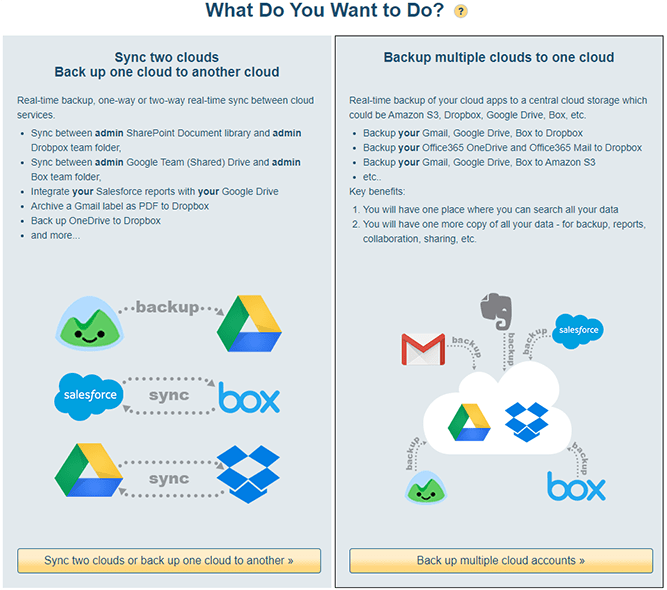
If you choose the IT admin option, a warning prompt will inform you that you have to be a Google Apps, Office 365, Dropbox Business or Box Enterprise admin. Selecting the single user option takes you to the next screen where cloudHQ will ask you if you want to sync two cloud storage accounts, or if you want to backup multiple cloud accounts to a single cloud.
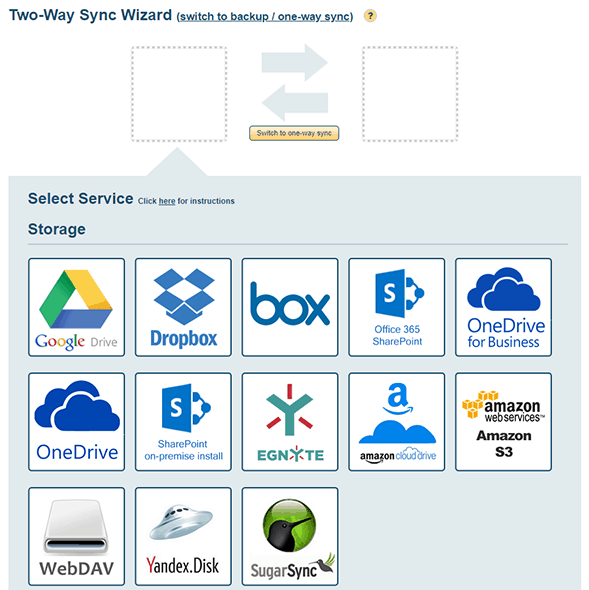
Syncing two cloud apps to one another using one-way or two-way sync is done in the “sync and backup” tab of the account. These cloud storage accounts are represented by two blank square boxes. Below them, you will find a list of supported services, divided into storage, email and applications sections.
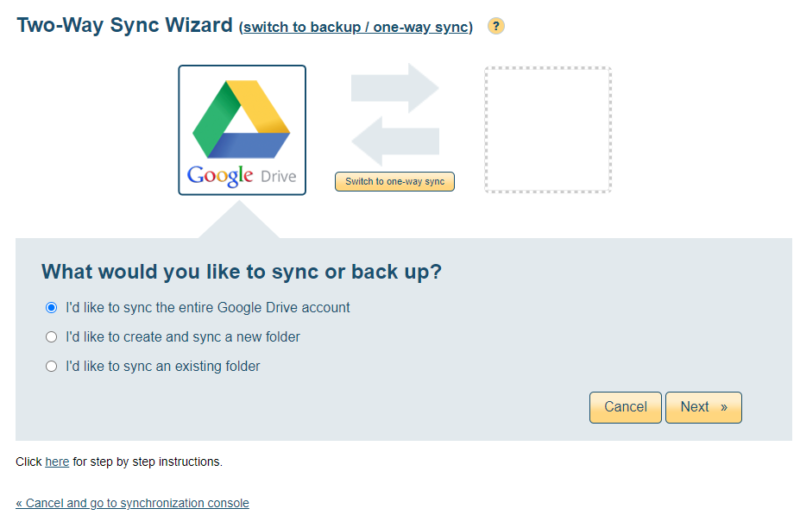
When you add one of these services, cloudHQ will request that you log in to the service and authorize cloudHQ to access it. For cloud storage services, you will have the option to sync your entire account, create and sync a new folder or sync to an existing folder. This service will then be added to your “cloud accounts” tab, and you will be able to manage it inside cloudHQ.
MultCloud vs cloudHQ Tools
Though cloudHQ is undoubtedly easy to use, its simplicity comes with a few drawbacks. When placed side by side with rival cloud-to-cloud management app MultCloud — read our full MultCloud review here — cloudHQ appears more streamlined and less cluttered.
However, this is almost entirely negated by a glaring lack of some key tools, such as the option to search through files on your cloud services.
When you enter a cloud storage folder through cloudHQ, you will see a list of all the files inside it, including the name of the file, its size, when it was last modified and the email of the file’s owner. While this is all useful information, you cannot preview any of these files or open them in their original cloud service.
Coupled with the absence of any sort of search tools, all of these missing features limit cloudHQ’s usefulness and capability as a proficient cloud-to-cloud management service. While we like its approach to designing an app that’s easy to use, we also have to point out that cloudHQ is weighed down by not having some of these basic functionalities.
Supported Cloud Services & Protocols
As we’ve mentioned in the pricing segment of this cloudHQ review, the cloud services you can connect to depends on your pricing plan.
cloudHQ’s free plan allows you to connect the free versions of your cloud storage accounts, while the Premium plan extends this to premium cloud accounts. The Business and Enterprise plans further increase this to include business cloud accounts, such as our favorite EFSS, Egnyte.
Besides integral cloud storage apps like Google Drive and Microsoft OneDrive (read more about these in our Google Drive review and OneDrive review), cloudHQ’s free plan also includes our favorite note taking apps, Evernote and OneNote. This plan also supports some of the best cloud email services, such as Gmail and iCloud (and some of our least favorite, like Yahoo Mail).
On the Premium plan, you have unlimited sync and backup of premium accounts, including Dropbox’s paid plans. However, cloudHQ only shows its true potential on the Business and Enterprise plans, which give you unlimited data transfer for backup and sync purposes with all of these, plus access to business cloud storage accounts.
In addition to supporting Amazon S3 — one of the most widely used cloud computing platforms — these two payment plans also support Slack and project management tools Asana and Basecamp.
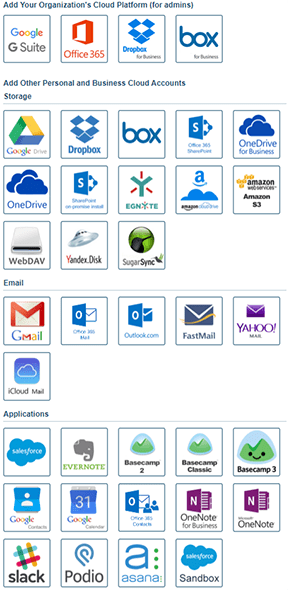
Here’s a full list of cloud services that cloudHQ supports:
Google’s G Suite
Box for Business
Box
OneDrive
Amazon Cloud Drive
Yandex.Disk
Office 365 Mail
Yahoo Mail
Evernote
Office 365 Contacts
OneNote for Business
OneNote
Salesforce Sandbox
Office 365
Google Drive
Office 365 SharePoint
SharePoint on-premise install
Amazon Web Services (Amazon S3)
SugarSync
FastMail
Salesforce
Google Contacts
Google Calendar
Slack
Asana
Dropbox for Business
Dropbox
OneDrive for Business
Egnyte
WebDAV
Gmail
Outlook.com
iCloud Mail
Basecamp 2
Basecamp Classic
Basecamp 3
Podio
With the WebDAV transfer protocol you will be able to connect cloud storage services that aren’t fully supported by the app, so long as these services also have WebDAV support. This allows you to add such cloud services as the fantastic pCloud.
The list of services cloudHQ can integrate with isn’t bad by itself, and it becomes even better when you take WebDAV into consideration, though we would have liked to see File Transfer Protocol here as well. Overall cloudHQ feels a bit limited in scope and functionality, in comparison to the amount of cloud services MultCloud supports.
Security & Privacy
When it comes to security and privacy, cloudHQ does a lot of things really well. Unlike many other cloud-to-cloud management services, it doesn’t beat about the bush but explicitly states — in plain language — exactly how it handles private data and files, and what its security measures are.
Of particular note — and something that we applaud — is that cloudHQ utilizes an internal data governance structure to ensure necessary accountability on an employee and company-wide level. This includes regular assessments of technical vulnerability, as well as constant port monitoring and the logging of all authenticated user actions.
Is cloudHQ Secure?
Yes, cloudHQ is secure. Each cloudHQ account is encrypted with a unique AES 256-bit key. Likewise, metadata on cloudHQ’s servers is encrypted with a randomly generated AES 256-bit key. User interactions and data transmissions with third-party APIs (such as customer relationship management app Salesforce) are handled via a 256-bit encrypted SSL channel.
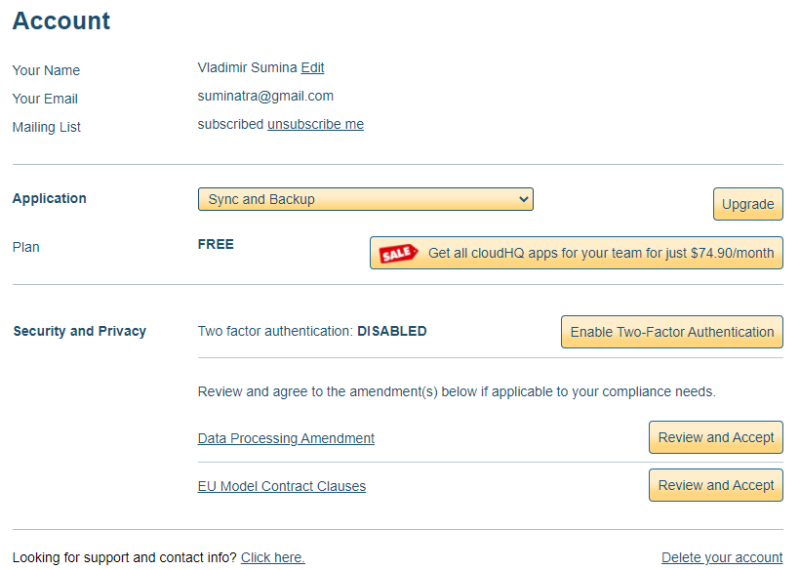
cloudHQ’s security is further bolstered by two-factor authentication, a security measure that ensures that even if your cloudHQ password gets compromised, your account will remain safe. When connecting to Google, Microsoft, Egnyte, Box and Dropbox, cloudHQ uses OAuth 2.0, a passwordless authorization protocol.
Services that do not have OAuth support still require the service’s username and password before cloudHQ can connect to them. These credentials are then encrypted with a 256-bit AES. When cloudHQ accesses your files, it may cache some of these contents temporarily, but it never permanently stores your files on its servers.
How Does cloudHQ Handle User Privacy?
First off, cloudHQ employees are prohibited from interacting with users’ files or seeing their filenames. If cloudHQ would ever need access to your files, its employees are obligated to ask for your explicit permission before they can do so. All of their actions will be logged, and you can request audit logs of this procedure.
cloudHQ collects only your name and email address. Payments can be done through PayPal, in which case no credit card billing information is stored on cloudHQ’s side. Please note that cloudHQ records information from your web browser — including your IP, browser type and which web pages you’ve visited — and that this service uses cookies.
This service places great emphasis on user privacy and is fully General Data Protection Regulation (GDPR) compliant. Besides the aforementioned tight data governance structure in place, which includes precisely defined user rights, cloudHQ has breach notification rules that run in real time and report users if a data breach occurs.
Customer Support
cloudHQ’s customer support options depend on the pricing plan. Free users get no direct support and have to rely on finding solutions to their problems by looking them up themselves in cloudHQ’s support section.
The good news is that cloudHQ has taken a lot of care to provide detailed explanations for each issue you are likely to encounter, and most of these have step-by-step screenshots included to make them even easier to follow.
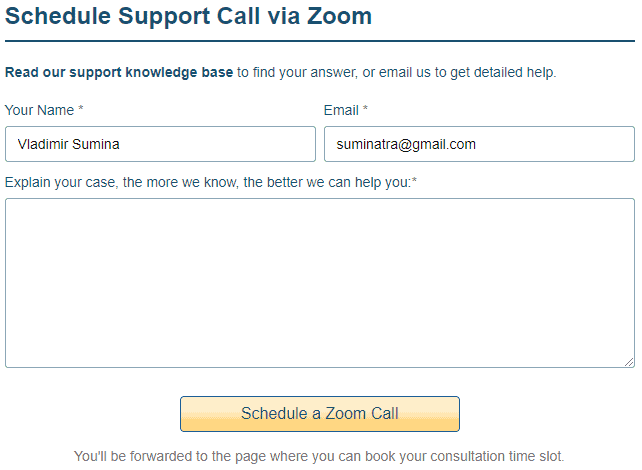
The Premium payment plan has email support, and the Business and Enterprise plans have both email and phone support. Calls can be done over Zoom, as well, but have to be scheduled in advance. There is also the option to request a demo, where a cloudHQ cloud infrastructure specialist will provide an app demonstration and answer questions you may have.
Overall, cloudHQ’s support is decent enough, but it could definitely be improved with advanced options, such as around-the-clock live chat and consistent support features for all plans, regardless if they are paid or free.
The Verdict
There are many reasons why you would want to pick cloudHQ as your cloud-to-cloud management app of choice. The most obvious is its phenomenal free plan, which you can use to sync your free cloud accounts without the data limitations that other cloud-to-cloud management services typically impose.
However, for everything that cloudHQ does well, there are always a couple of related areas where it falls flat. With no search tool, no file previews and no option to open files directly in the source cloud apps, cloudHQ’s overall usefulness is limited to setting up cloud storage app sync relationships.
We hope that you have found our cloudHQ review helpful and informative. Are you a current or past cloudHQ user? What do you think of this app? Do you agree with our assessment of it, or do you think we should have mentioned some other outstanding cloudHQ features? Tell us in the comments below. As always, thanks for reading.
FAQ
cloudHQ is a cloud-to-cloud management service that you can use to control your cloud storage accounts. It’s easy to use, and when you link your cloud services to cloudHQ, you will be able to migrate data from one cloud storage to another, or set up one- or two-way syncing for backup purposes.
Yes, cloudHQ is one of the most secure and user privacy–oriented cloud-to-cloud management apps. It offers AES 256-bit encryption, two-factor authentication and a strict adherence to data governance principles (which also includes GDPR compliance).
cloudHQ has a free plan and three paid plans. On the free plan, you can link free cloud service accounts with unlimited sync and backup data. You can get a paid cloudHQ subscription starting from $39.20 per month or $118 per year per user.
If you want to delete your cloudHQ account, all you have to do is go to your account settings and click on the “delete your account” option. This will take you to a survey consisting of two short questions. After filling these out, you will be able to confirm that you want to delete your cloudHQ account.





